Realism paintings are a fascinating genre of art that emerged in the 19th century. These works of art depict the world around us in a realistic and detailed manner, often capturing everyday life, landscapes, and portraits. The realism movement aimed to represent the world as it is, without idealizing or romanticizing it. This makes it a unique and important movement in the history of art.
In this article, we will explore some of the most famous realism paintings and analyze their style, subject matter, and significance. We will take a closer look at the works of artists such as Gustave Courbet, Édouard Manet, and Thomas Eakins, and examine how they contributed to the development of realism. By understanding the techniques and themes of these paintings, we can gain a deeper appreciation for this important movement and its impact on the art world.
1. Nighthawks (1942) By Edward Hopper
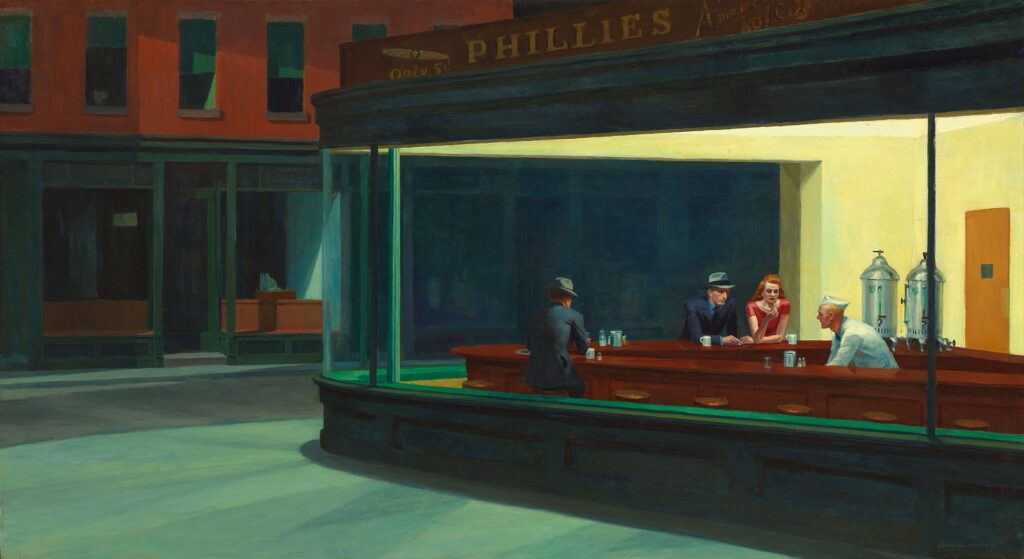
Edward Hopper’s Nighthawks (1942) is an iconic realist painting that portrays four individuals sitting in a brightly lit diner in the middle of the night. The painting is consistent with Hopper’s style, which often features isolated people and settings, as well as a sense of loneliness and detachment.
The stark contrast between the bright interior lights and the dark exterior highlights the isolation of the individuals inside. Each individual appears lost in thought, creating an overall atmosphere of introspection.
2. The Gross Clinic By Thomas Eakins (1875)
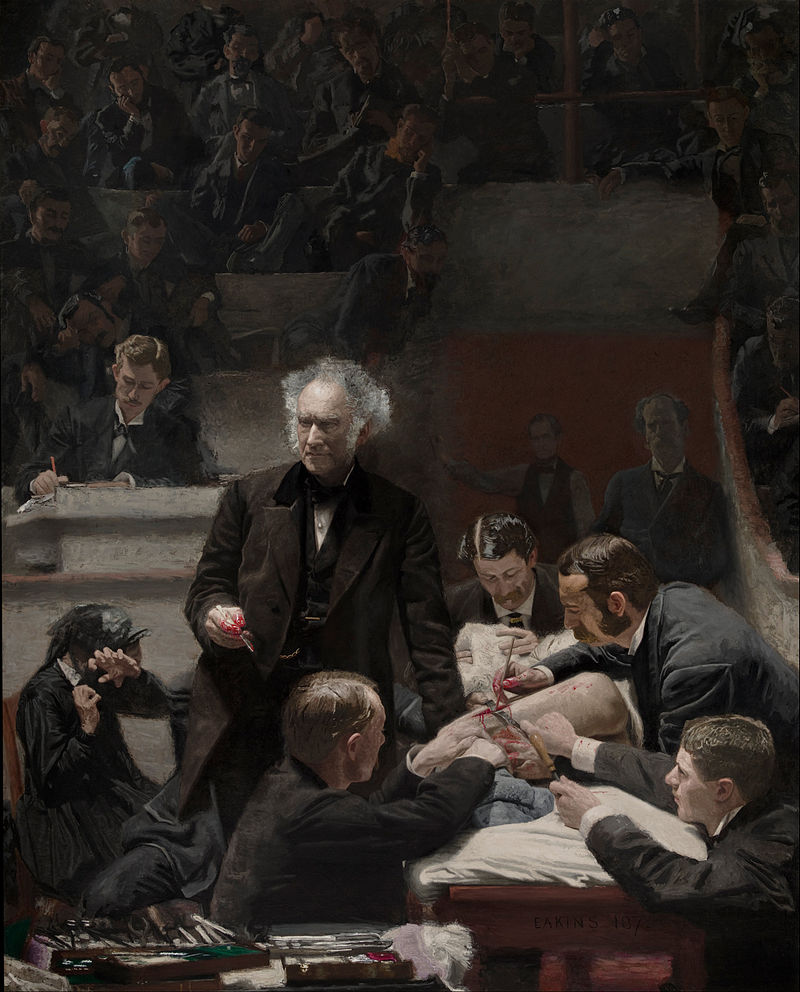
The Gross Clinic is a painting created by Thomas Eakins in 1875. The oil on canvas artwork measures eight feet by six and a half feet and depicts Dr. Samuel D. Gross performing surgery on a patient’s thigh while surrounded by an audience of medical students. The painting is set in the surgical theater of Philadelphia’s Jefferson Medical College, where Eakins studied anatomy and attended surgeries.
The Gross Clinic has been praised for its brutal honesty in portraying surgery during the 19th century. The painting accurately shows the blood, gore, and intensity involved in surgical procedures of that time period. In addition to its realism, Eakins also displayed medical knowledge by painting anatomically correct details like the positioning of instruments and surgical procedure.
Despite its historical accuracy, The Gross Clinic was initially met with controversy due to its graphic nature that was deemed unsettling to some members of society at that time. However, it eventually became recognized as one of America’s greatest works of art because it realistically depicted a significant moment in history.
3. Burial At Ornans (1849) by Gustave Courbet
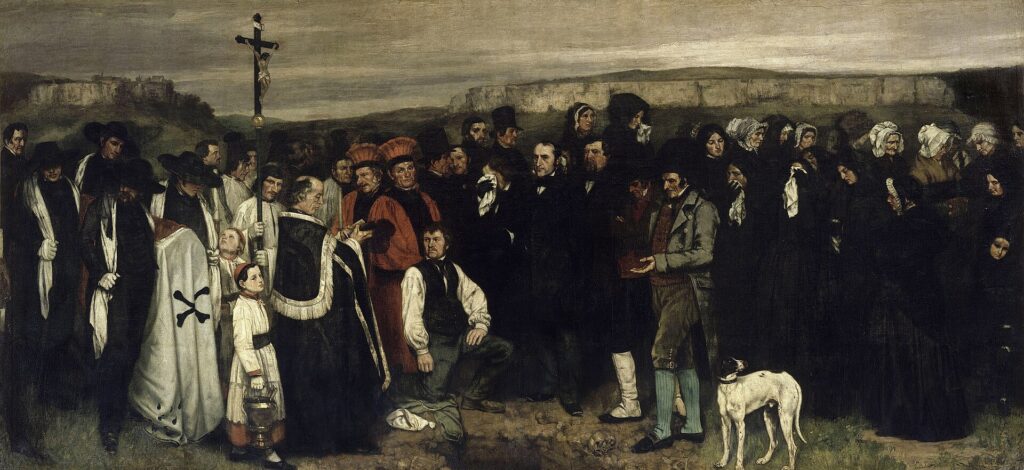
Burial at Ornans is an 1849 oil painting by French artist Gustave Courbet. The painting is often cited as a prime example of realism in art, as it depicts a scene that is not traditionally considered to be beautiful or glamorous: a funeral in a small French town.
The painting shows a large group of people gathered around an open grave, dressed in plain and practical clothing rather than the elaborate costumes typically seen in paintings from the time. Courbet himself appears prominently in the foreground of the painting, holding his hat and looking down somberly at the scene.
Beyond its realistic depiction of an ordinary event, Burial at Ornans also caused controversy for its sheer size. Measuring 315 cm × 660 cm, the painting was intended to depict its subjects on a monumental scale that was more typically reserved for grand historical scenes or mythological dramas.
Burial at Ornans remains an important work both for its style and subject matter. By portraying ordinary life with such detail and seriousness, Courbet helped pave the way for other artists to experiment with similarly realistic styles throughout the later 19th century.
4. Christina’s World (1948) By Andrew Wyeth
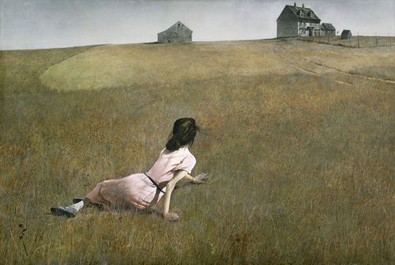
Christina’s World, painted in 1948 by Andrew Wyeth, is a classic example of American realism. The painting depicts a young woman in a pink dress lying on the ground and looking out at a distant farmhouse. The simplicity of the composition and muted color palette creates a sense of melancholy and isolation.
One interesting fact about Christina’s World is that it was inspired by an actual place and person. Wyeth painted the scene from his summer home in Maine, where he often visited his neighbor Anna Christina Olson. Olson suffered from a degenerative muscle disorder that left her unable to walk or stand without assistance. In the painting, she is shown crawling across the field towards the distant house.
The painting has become an iconic image in American art history and has been interpreted in many different ways. Some viewers see it as a commentary on disability or illness, while others find it to be a poignant representation of isolation and longing. Regardless of its interpretation, Christina’s World remains one of Wyeth’s most famous works and continues to captivate viewers with its haunting beauty.
5. The Elder Sister By William-Adolphe Bouguereau (1869)
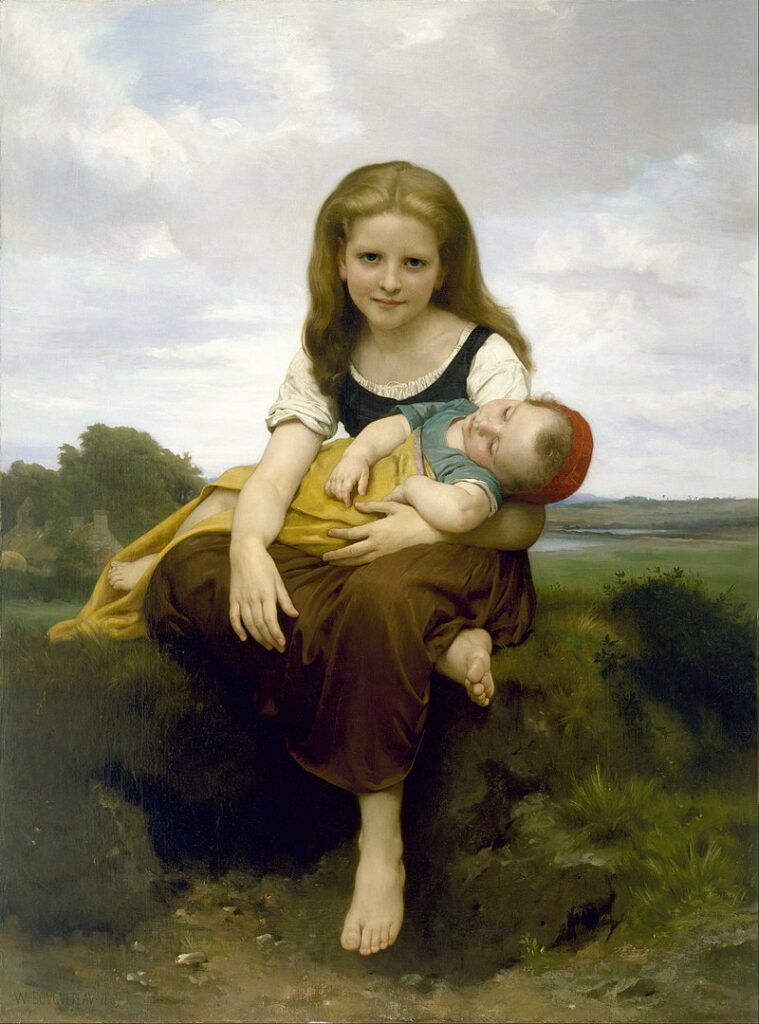
The Elder Sister by William-Adolphe Bouguereau is a beautiful example of Realism painting from the 19th century. The painting features a young girl holding her baby sibling, both dressed in simple white clothing against a warm-colored background. The fine details and realistic depiction of the figures make it one of Bouguereau’s most celebrated works.
Bouguereau was known for his technical skill in portraying realistic figures in paintings, and The Elder Sister is no exception. From the intricate folds of their clothing to the softness of the baby’s skin and the girl’s hair, every detail is painstakingly rendered with incredible precision.
However, beyond its technical excellence, The Elder Sister also tells an emotional story about love and family. As we look at the gentle expression on the sister’s face as she cradles her younger sibling, we can feel a deep sense of tenderness and protection emanating from the painting.
6. Bonjour Monsieur Courbet By Gustav Courbet (1854)
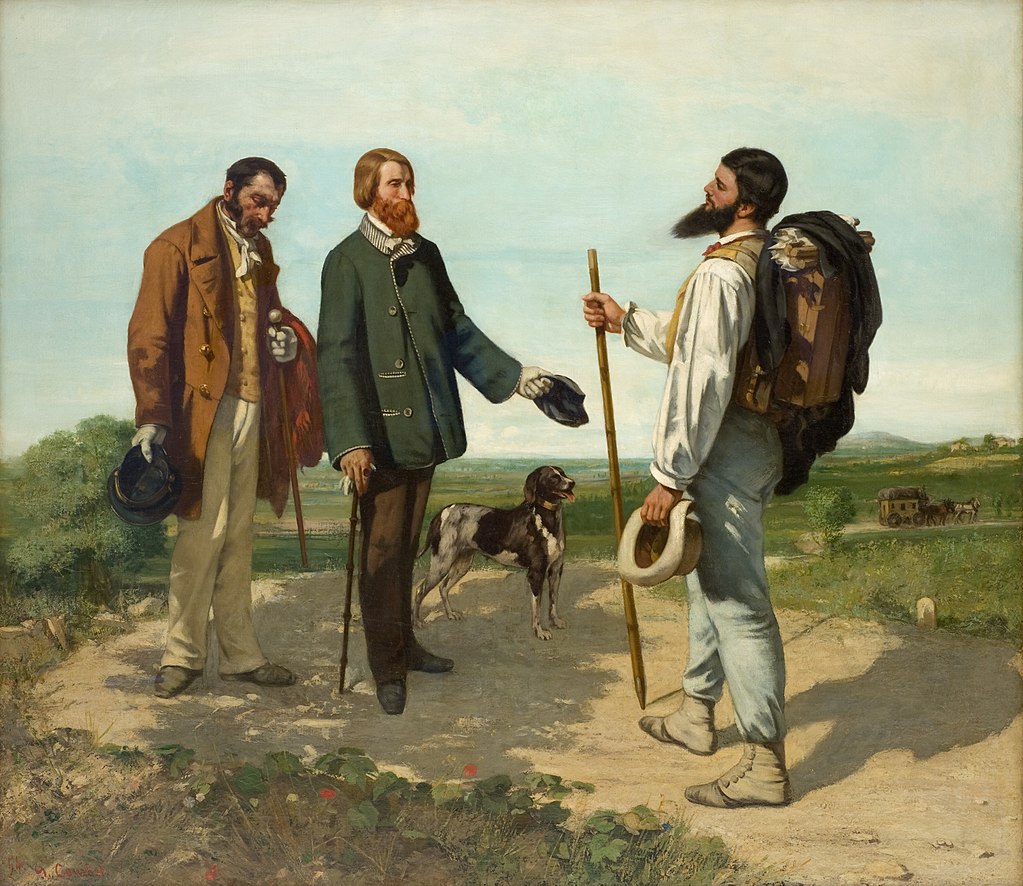
Gustav Courbet’s painting “Bonjour Monsieur Courbet” is a remarkable example of Realism in art. The painting was created in 1854 and depicts the artist himself walking with his guide, who is carrying his bags. The scene takes place in the French countryside, as evidenced by the lush greenery and rolling hills visible in the background.
What makes this painting notable is its attention to detail and dedication to realism. Every aspect of the scene has been carefully rendered, from the folds in Courbet’s jacket to the texture of his guide’s hat. This commitment to authenticity was a hallmark of Realism as an art movement.
Courbet’s choice to depict himself as an artist on a journey highlights another key aspect of Realism: its focus on everyday life rather than grand themes or historical events. By placing himself at the center of the painting, he draws attention to his own role as an observer and commentator on society.
7. The Gleaners By Jean François Millet
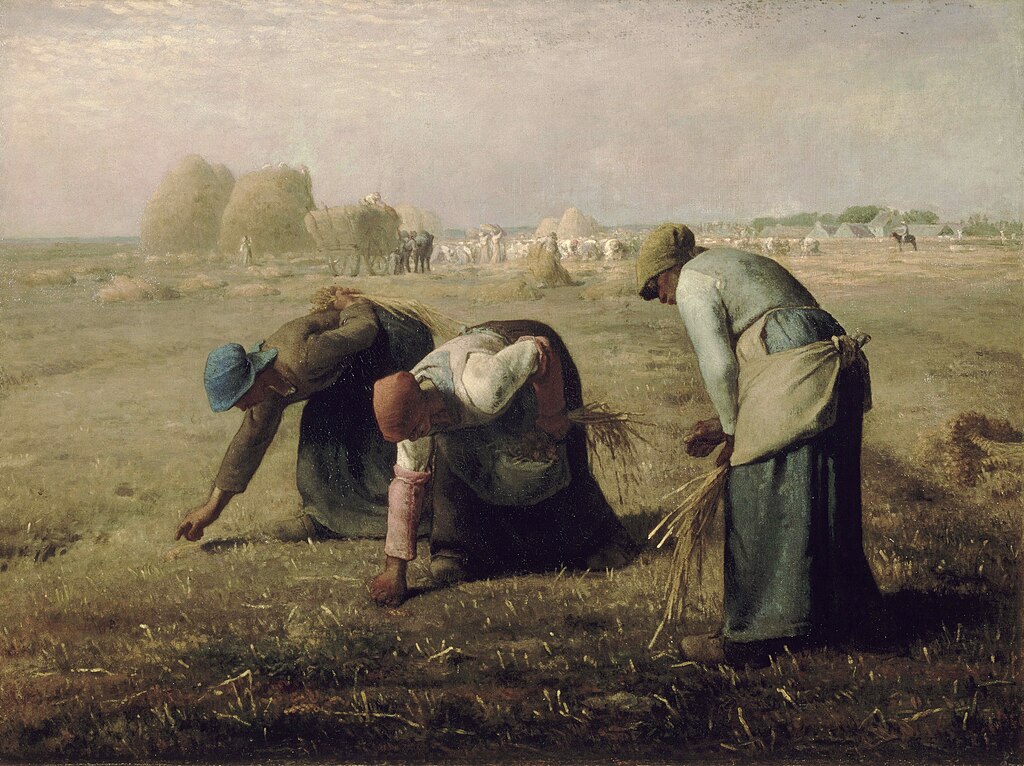
The Gleaners is a masterpiece created by French painter Jean François Millet in 1857. The painting portrays three women, bent over as they collect leftover grains from a harvested wheat field. It serves as a representation of the working-class life during the mid-19th century, highlighting how everyday people made use of even the smallest resources to make ends meet.
Millet was known for his realistic and empathetic portrayal of peasants and rural life, having grown up in that environment himself. The painting’s muted colors and rough brush strokes add to its rustic charm, contrasting with other contemporary paintings that prioritized idealized depictions of people. Instead of portraying opulence or grandeur to appeal to upper-class viewers, Millet sought to elevate everyday laborers’ dignity by making their lives visible through art.
The Gleaners has become an icon of social realism and remains significant today for its early expression of labor politics. Its portrayal resonates with discussions surrounding food waste reduction, rural poverty alleviation measures and employment issues in present times.
8. The Stone Breakers By Gustave Courbet
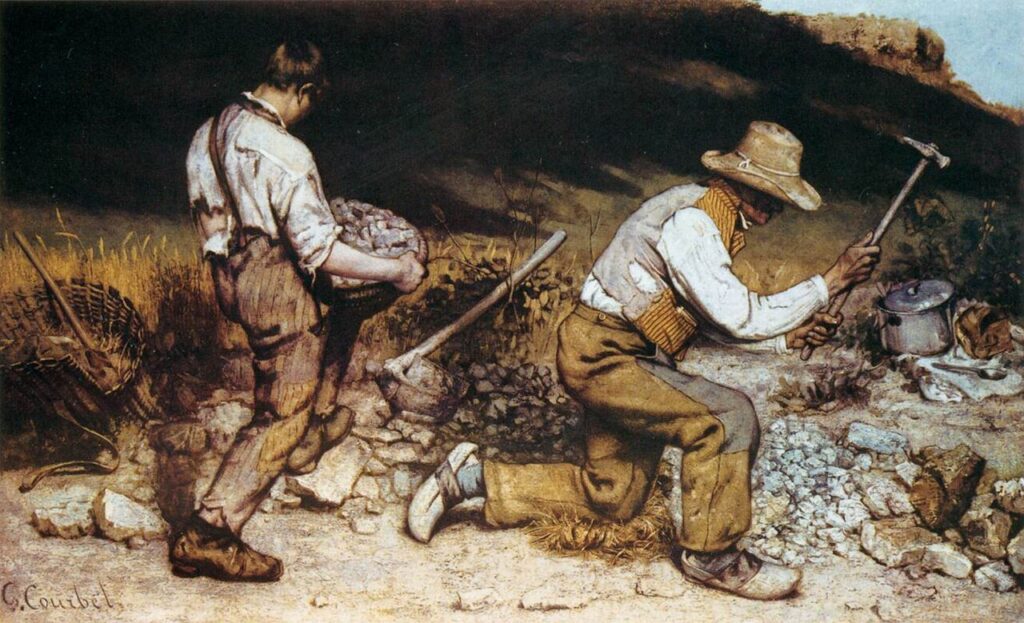
The Stone Breakers is one of the most well-known paintings by French artist Gustave Courbet, an iconoclastic Realist painter who challenged traditional artistic conventions. The painting depicts two men breaking stones on a roadside, and it is believed to be a commentary on the plight of the working class in 19th century France.
Courbet sought to depict everyday life in his Realist paintings, which often celebrated ordinary people and their struggles. In The Stone Breakers, he portrays the harsh reality of physical labor and its toll on the human body. The two figures are rendered with great detail, their weathered faces and calloused hands capturing the difficulties they face each day.
The painting was controversial when it was first exhibited at the Salon in Paris in 1850 because of its gritty subject matter and bleak outlook. However, it has since become recognized as one of Courbet’s masterpieces and a seminal work in the history of Realism. The Stone Breakers remains an enduring symbol of social critique that has resonated with generations of viewers.
9. Olympia By Édouard Manet (1863)
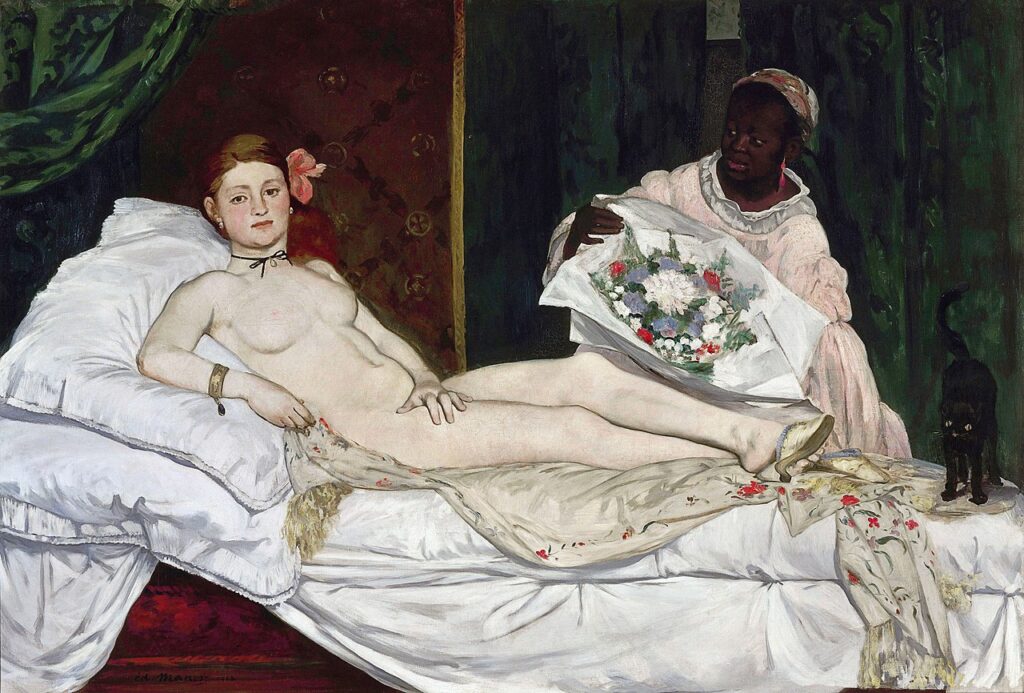
Édouard Manet’s painting, Olympia, is a prime example of Realism art. Created in 1963, the painting depicts a nude woman lying on a bed while looking directly at the viewer. This stirred controversy and was considered scandalous upon its unveiling to the public in 1865.
One of the most significant features of this artwork is how Manet rendered his subjects realistically. He chose to depict Olympia as an everyday woman instead of the traditional idealized versions seen in classical paintings. This realism challenged the conventional standards of beauty and repelled many critics at that time.
The lighting in this painting is also noteworthy, with light falling on Olympia’s figure from a window to her left and casting shadows across her body. In addition, the black cat at her feet symbolizes sexuality and can be interpreted as a reference to prostitution.
Despite its initial controversy, Olympia has become an iconic piece in art history due to its brave departure from traditional artistic conventions. Its influence can be seen throughout subsequent movements such as Impressionism and Modernism.
10. Woman With A Parrot By Gustave Courbet (1866)
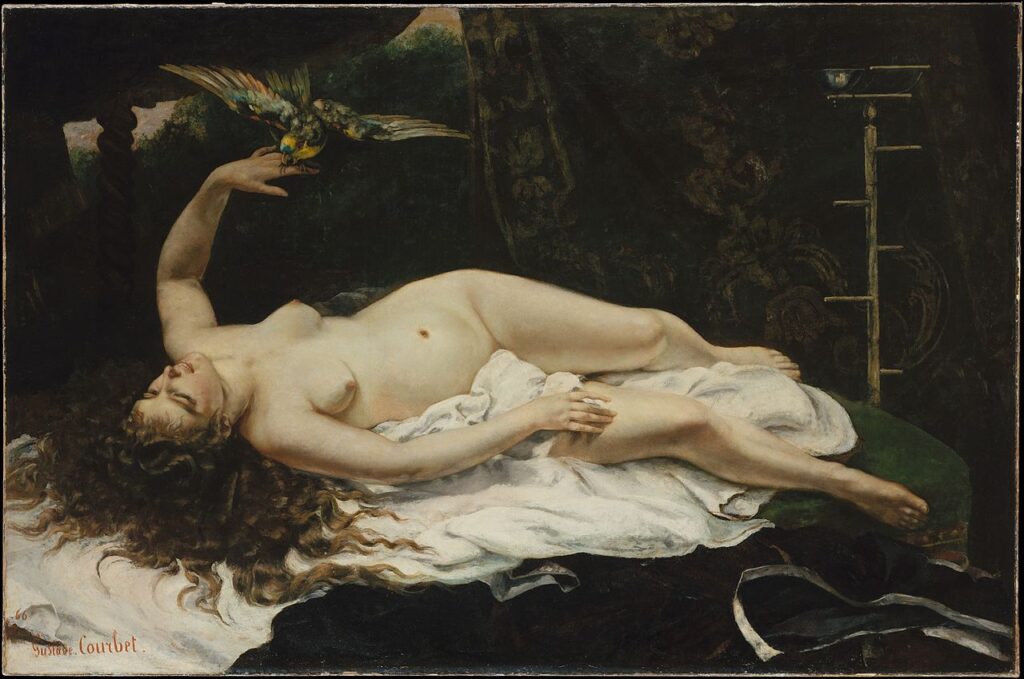
Gustave Courbet’s Woman with a Parrot is a stunning example of Realism art from the mid-19th century. The painting depicts a young woman, dressed in rich fabrics and holding a parrot on her hand, set against an imposing dark background. Courbet’s attention to details is remarkable; he captures every nuance in the woman’s body, facial expression, and even the bird’s feathers.
One aspect that stands out in this painting is how realistic it is. Courbet was known for his commitment to portraying life as it was, avoiding any romanticized or exaggerated depictions of reality. In Woman with a Parrot, he captures not only the physical likeness of his subject but also conveys her emotions through subtle changes in her face and body language.
Another notable element of this painting is its composition. By placing the woman center stage against an almost-black background, Courbet draws all attention to her figure and creates drama through contrast. The parrot becomes almost like an extension of her arm or even part of her clothing instead of just an accessory.
11. La Nymphe Surprise By Édouard Manet (1861)
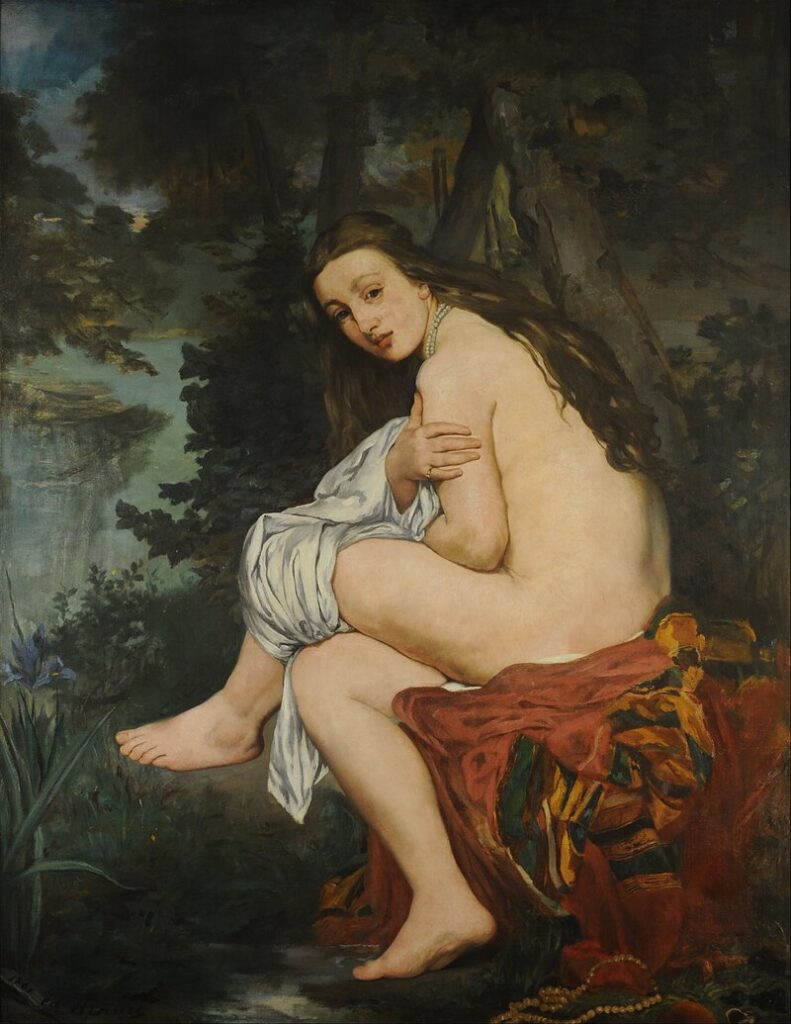
La Nymphe surprise by Édouard Manet is a painting that depicts a mythological scene of a nymph being surprised while bathing in a stream. The painting was created in 1861 and is considered to be an example of realism art, which focused on capturing everyday scenes and objects in a lifelike manner.
Manet’s use of vivid colors and attention to detail make the nymph seem almost real, with her finely detailed skin and hair contrasting with the muted tones of the background. The scene is staged as if it were frozen in time, with the nymph caught in mid-gesture as she turns to see who has interrupted her bath.
Though the scene is based on Greek mythology, Manet’s treatment of it was revolutionary for its time and is considered to be one of his most iconic paintings. La Nymphe surprise displays a mastery of both composition and technique, showcasing Manet’s skill at rendering light, color, and movement.
12. Portrait Of An Unknown Woman By Ivan Kramskoi
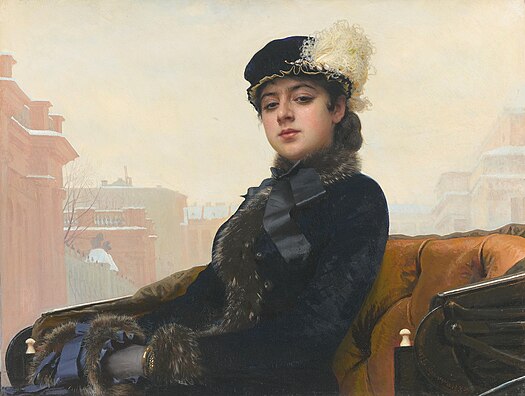
Portrait of an Unknown Woman, or Stranger, is a realist painting painted by Russian artist Ivan Kramskoi in 1883. The painting is considered one of Ivan Kramskoi’s masterpieces.
The strong sense of realism in the painting can be seen in the attention to detail on the woman’s face, particularly her eyes which seem to engage the viewer directly. She has a serious expression, and a “quiet strength”. The use of chiaroscuro, or the contrast between light and dark areas, adds depth to the painting.
Kramskoi was known for his portraits of people from all walks of life, including peasants and workers. However, Portrait of an Unknown Woman stands out as it portrays someone from an upper-class background. Despite this difference, he still manages to portray her humanity through his style that emphasizes honesty over glamour.
13. The Wheat Sifters By Gustave Courbet
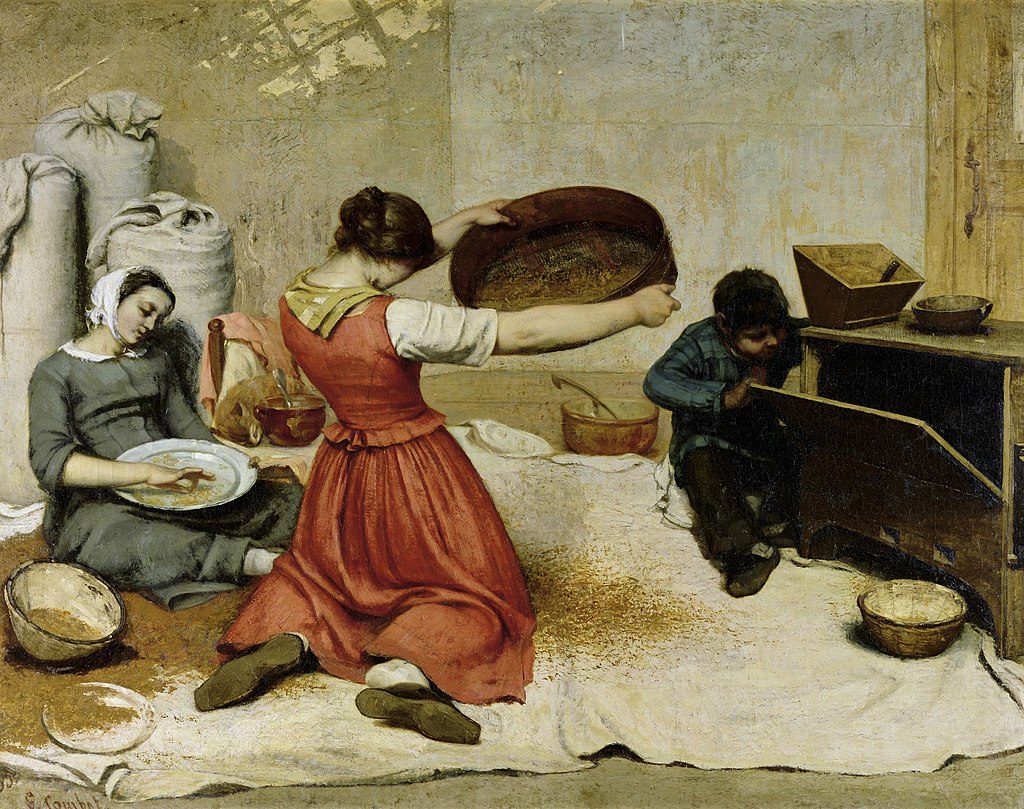
Gustave Courbet was a prominent figure in the Realism movement of the 19th century, known for his depictions of everyday life. One of his notable works is The Wheat Sifters, painted in 1855, which is thought to depict his two sisters (Zoe, center) and Juliet (left), and a young boy, which may be the illegitimate son of Courbet.
The painting features Courbet’s signature realistic style, with its attention to detail and focus on capturing the ordinary moments of life. The use of warm earth tones gives the painting a natural feel, which adds to its charm.
14. Skull Of A Skeleton With Burning Cigarette By Vincent Van Gogh (1886)
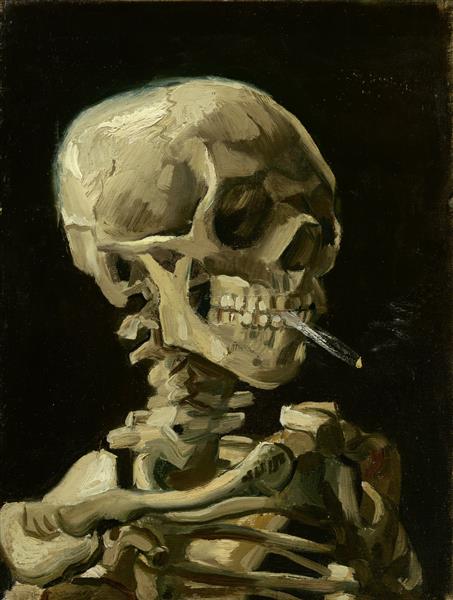
Skull of a Skeleton with Burning Cigarette is an oil on canvas painting painted by Vincent Van Gogh in 1886. It measures 32.3 cm x 24.8 cm and currently resides at the Van Gogh Museum in Amsterdam.
Van Gogh painted this as a young man while attending art school in Antwerp. Drawing skeletons is a common educational practice for art students, and it is thought that Van Gogh painted a skeleton with a cigarette as an attempt at humor.
15. Reply Of The Zaporozhian Cossacks To Sultan Mehmed IV Of The Ottoman Empire By Ilya Repin
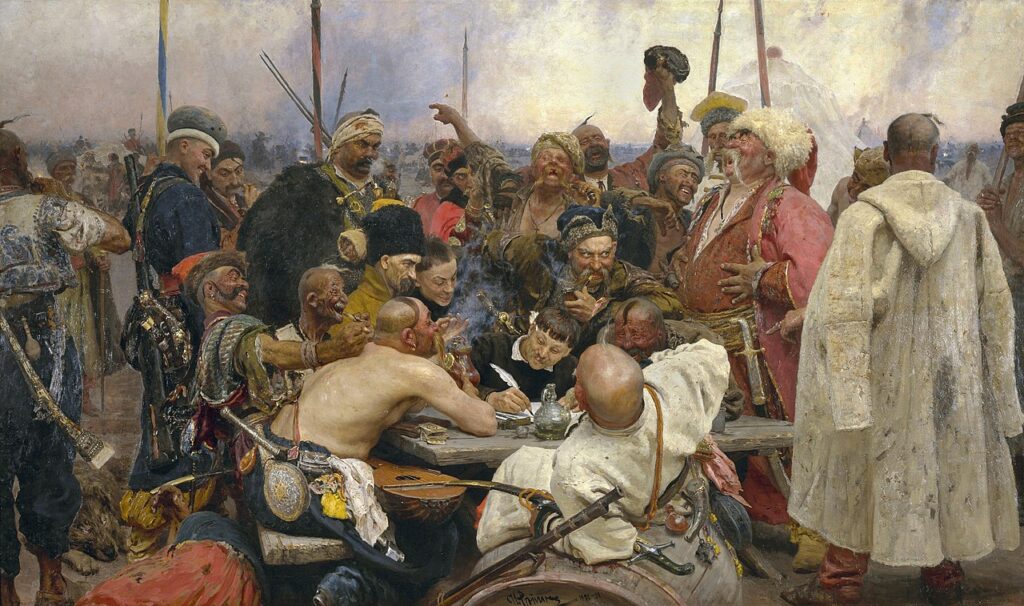
“Reply of the Zaporozhian Cossacks to Sultan Mehmed IV of the Ottoman Empire” is a painting depicting a group of Cossacks responding to a letter from the Ottoman Sultan with vulgarity and rejection. The artwork represents the rebellious spirit of the Cossack people, known for their independence and military prowess. Ilya Repin created this masterpiece in 1891 as part of his Russian Realism series, which aimed to depict everyday life in Russia.
The painting portrays a historical event that took place in 1676 during a period of tension between the Turkish Ottoman Empire and Russia’s early state. The Cossacks replied insultingly to Sultan Mehmed’s demand for their submission, challenging his authority through crudeness and profanity.
This work has become an iconic symbol of Russian history and Ukrainian nationalism over time. Repin’s realistic portrayal captures both the crude humor and military strength that characterized Cossack culture, making it essential viewing for those who wish to understand more about Eastern European history.
16. The Balcony By Édouard Manet
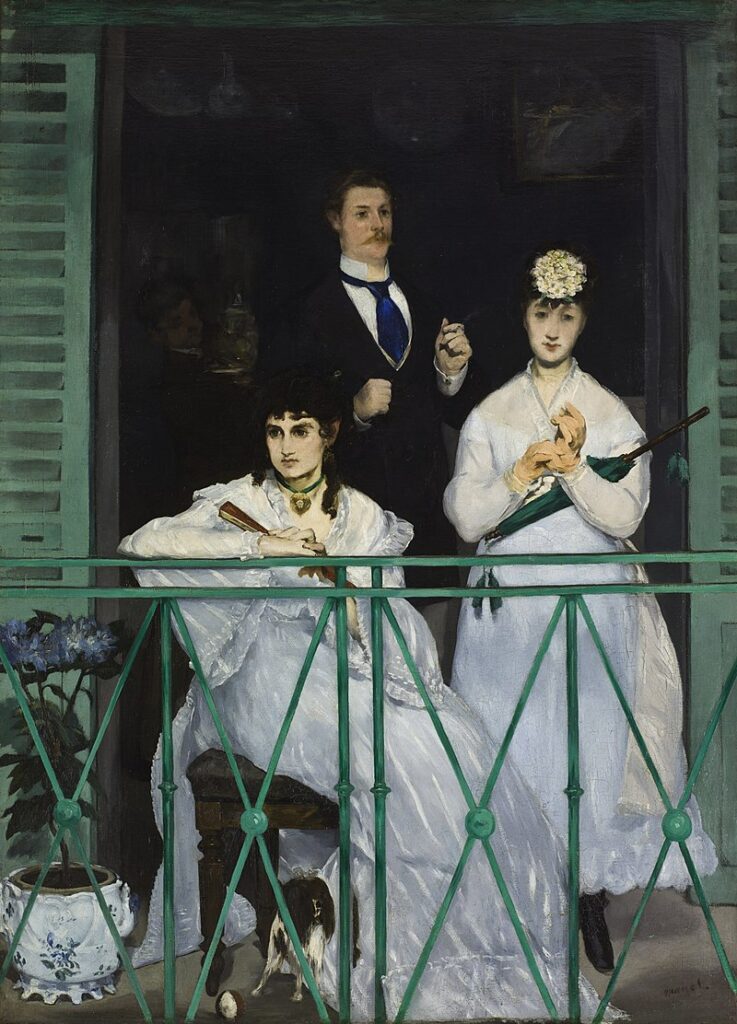
Édouard Manet’s The Balcony is a painting that depicts four figures, two women and one man, and one obscured figure, a boy. These figures are thought to depict Manet’s actual friends and family, including artist Berthe Mirisot (seated), Jean Baptise Antoine Guillemet (center), and violinist Fanny Clause (right). The obscured figure of a boy on the left is thought to be Manet’s son, Leon Leenhoff.
Manet’s use of loose brushstrokes and muted colors was characteristic of his approach towards realism. He sought to capture modern life in an honest way without idealizing or romanticizing it. For example, unlike traditional paintings where every detail is carefully rendered, Manet’s figures often lack facial features or details.
The Balcony was not initially well-received by critics due to its departure from traditional art styles. However, it has since become recognized as a groundbreaking work in Realism art history for its depiction of modern life and new ways of representing women’s role in society through visual means.
17. The Bellelli Family By Edgar Degas
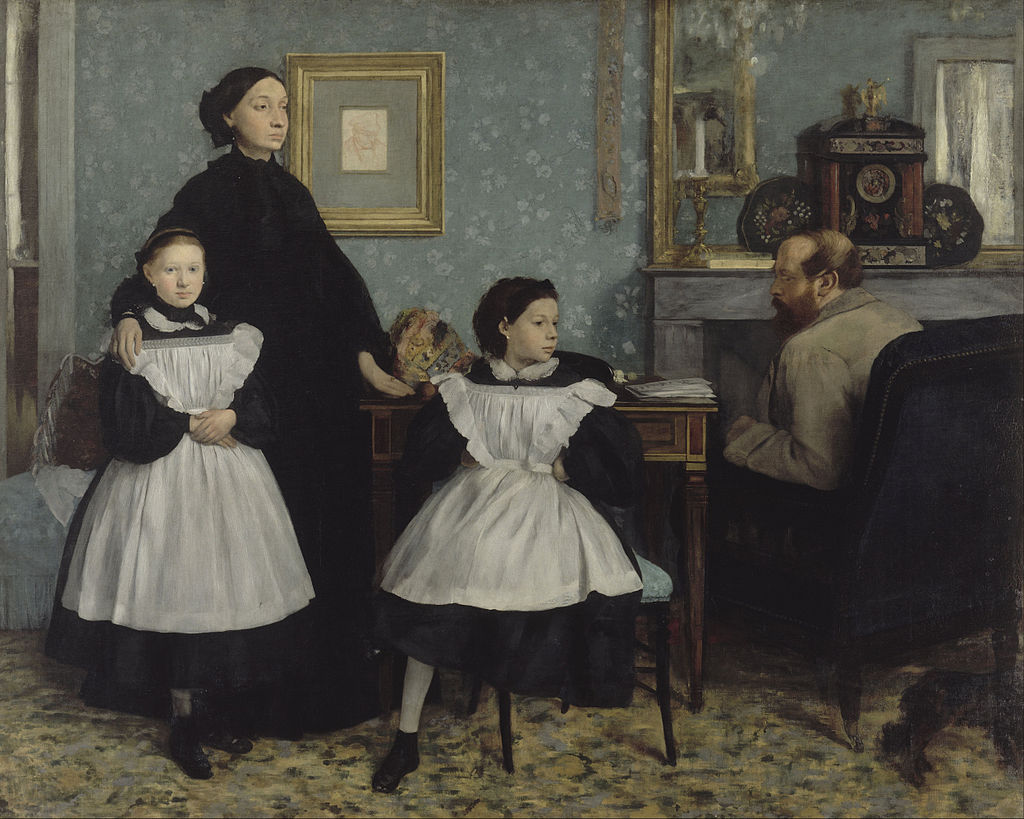
The Bellelli Family is one of the most well-known paintings by the French artist Edgar Degas, known for his realism style. This painting was made c. 1858–1867, and depicts Degas’ aunt, uncle, and cousins. The painting portrays Degas’ aunt in a mourning dress, which is thought to indicate her visiting her father’s funeral. The uncle is seated at a desk, indicate his preoccupation with business, and a emotional separation from the family.
Degas’ use of lighting in The Bellelli Family is noteworthy as he uses both natural and artificial light to create depth and contrast. He employs an overhead light source that casts shadows on their faces, emphasizing their somber expressions and hinting at an underlying sadness within the family. The room’s wallpaper patterns also add another layer to this work as they complement each character’s outfit while contrasting with other elements.
18. Whistler’s Mother By James McNeill Whistler
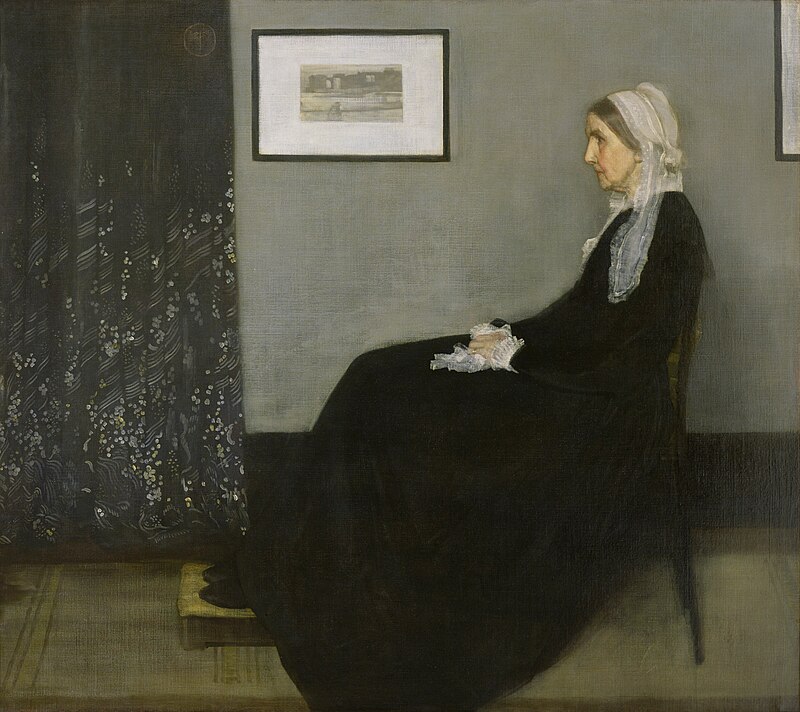
James McNeill Whistler’s painting “Whistler’s Mother” is an iconic example of Realism art. The painting depicts Whistler’s mother, Anna McNeill Whistler, sitting in a chair and wearing a black dress with a white lace collar. The background is neutral, consisting only of a gray wall and green curtain. This simple composition emphasizes the subject’s face and her gentle expression.
Whistler painted this portrait in 1871 when he was living with his mother in London. His intention was to capture her character in a way that was honest yet respectful. The use of light and dark tones creates depth and texture, giving the painting a three-dimensional effect that adds to its realism.
The painting has become an iconic image in popular culture, recognized around the world as one of the most famous portraits ever created. It has been parodied countless times in advertising campaigns, films, music videos, and even on postage stamps. In 2006 it became the centerpiece of an exhibit at the Musée d’Orsay in Paris which explored its influence on other artists throughout history.
19. Ploughing In The Nivernais (1849) By Rosa Bonheur
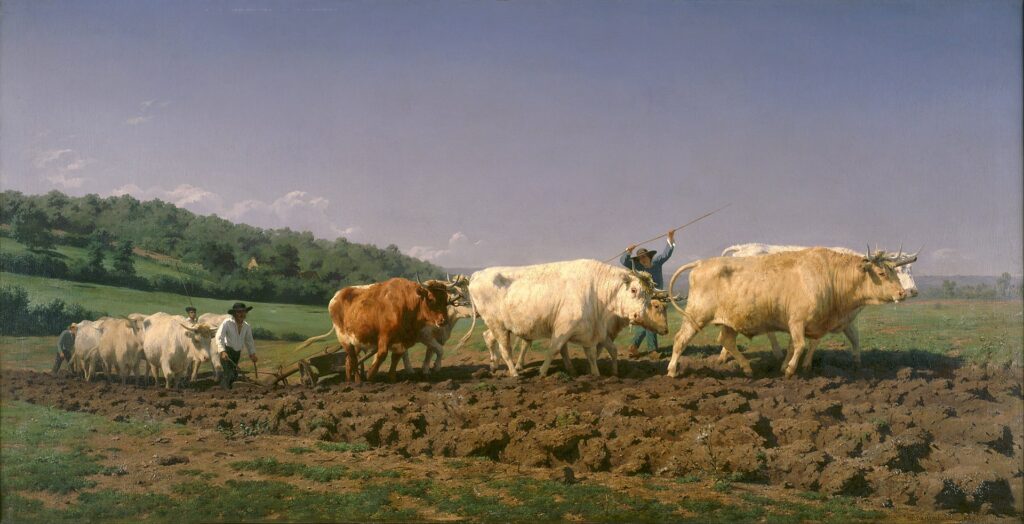
“Ploughing in the Nivernais,” a painting by Rosa Bonheur, is a masterpiece of animal painting. Completed in 1849, the painting depicts a farmer guiding a team of oxen as they plow through a field. The painting is highly praised for its realism and attention to detail, showcasing not only Bonheur’s technical skill but also her understanding of rural life and agriculture.
Bonheur’s choice to paint this scene with such accuracy was influenced by her interest in the natural world and her desire to capture every aspect of it on canvas. She spent hours observing animals in their natural environment before beginning any painting, ensuring that each animal was depicted with precision and authenticity.
The painter’s dedication to realism is evident not only in the portrayal of the animals but also in the landscape surrounding them. The fields of grain are rendered with striking detail, reflecting Bonheur’s fascination with botany as well as her deep love for nature.
Today, “Ploughing in the Nivernais” can be found at the Musee d’Orsay in Paris. The painting stands as a testament not only to Bonheur’s artistic prowess but also to her commitment to depicting rural life with honesty and respect.
20. The Horse Fair (1852 – 1855) By Rosa Bonheur
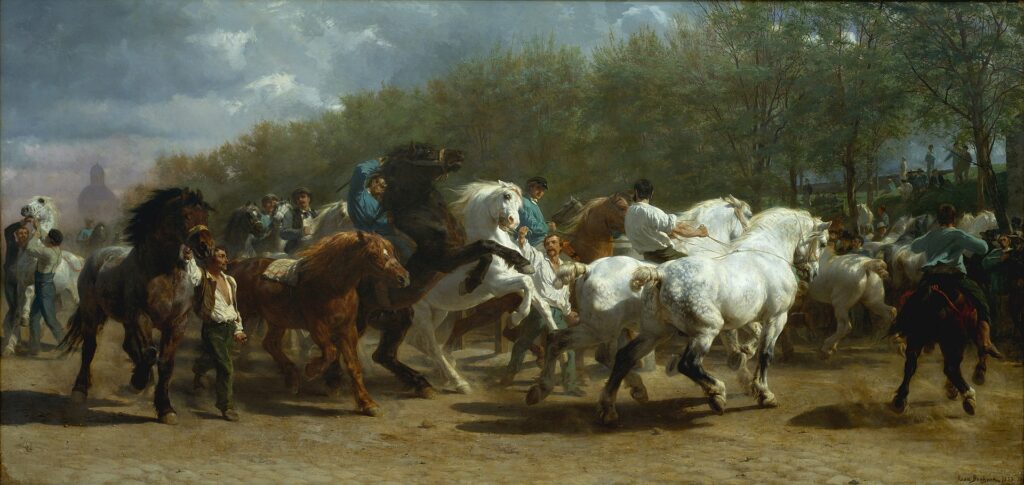
The Horse Fair (1852 – 1855) is a famous painting created by Rosa Bonheur, depicting a bustling outdoor horse market in Paris. The painting, which is over 16 feet long and 8 feet tall, is considered one of the most popular animal paintings in the world.
Bonheur attended the market several times to sketch and observe the horses, which enabled her to capture their individual personalities and characteristics. Each horse and person in the painting is meticulously portrayed with great detail. This level of detail in The Horse Fair makes it an impressive example of realism painting from this era.
21. The Angelus (1857 – 1859) By Jean-François Millet
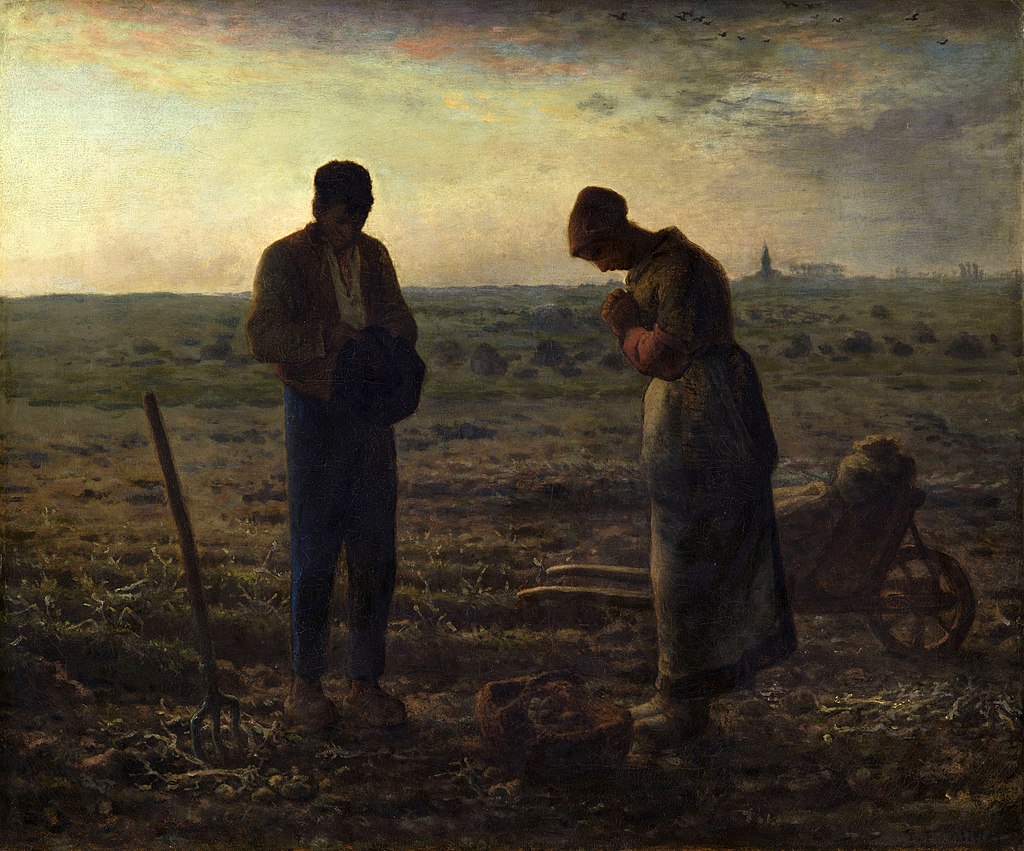
The Angelus (1857 – 1859) is a Realism painting by the French artist Jean-François Millet. The painting depicts a couple, a man and woman, working in the fields during harvest time with their tools at rest. They have paused their work to pray together, as indicated by the church bell in the background. The scene is set against a vivid sunset sky that vividly melts into blue and orange hues.
Millet’s artwork was celebrated for its portrayal of common people engaged in everyday work activities around rural France, especially peasants. His art was also admired for its precise detail and lighting that gave his paintings life-like quality.
The Angelus showcases Millet’s talent for depicting minute details such as dress styles, facial expressions, wrinkles on clothes, and body postures: these are all precisely rendered to bring out realism in his artwork. Moreover, Millet does not shy away from addressing real-life struggles faced by peasants including poverty and religious beliefs making this representation one of transformational resistance.
